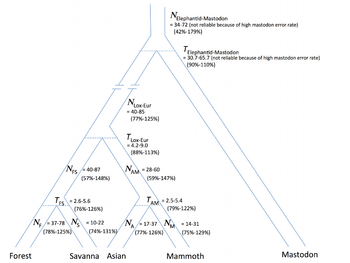Elephantidae
Elephantidae is a family of large, herbivorous proboscidean mammals collectively called elephants and mammoths. These are terrestrial large mammals with a snout modified into a trunk and teeth modified into tusks. Most genera and species in the family are extinct. Only two genera, Loxodonta (African elephants) and Elephas (Asiatic elephants), are living.
The family was first described by John Edward Gray in 1821,[4] and later assigned to taxonomic ranks within the order Proboscidea. Elephantidae has been revised by various authors to include or exclude other extinct proboscidean genera.
Scientific classification of Elephantidae taxa embraces an extensive record of fossil specimens, over millions of years, some of which existed until the end of the last ice age. Some species were extirpated more recently. The discovery of new specimens and proposed cladistics have resulted in systematic revisions of the family and related proboscideans.
Elephantids are classified informally as the elephant family, or in a paleobiological context as elephants and mammoths. The common name elephant primarily refers to the living taxa, the modern elephants, but may also refer to a variety of extinct species, both within this family and in others. Other members of the Elephantidae, especially members of the genus Mammuthus, are commonly called mammoths.
The family diverged from a common ancestor of the mastodons of Mammutidae. The classification of proboscideans is unstable and has been frequently revised.
The following cladogram shows the placement of the genus Mammuthus among other proboscideans, based on a 2007 study of hyoid characteristics:[2]



